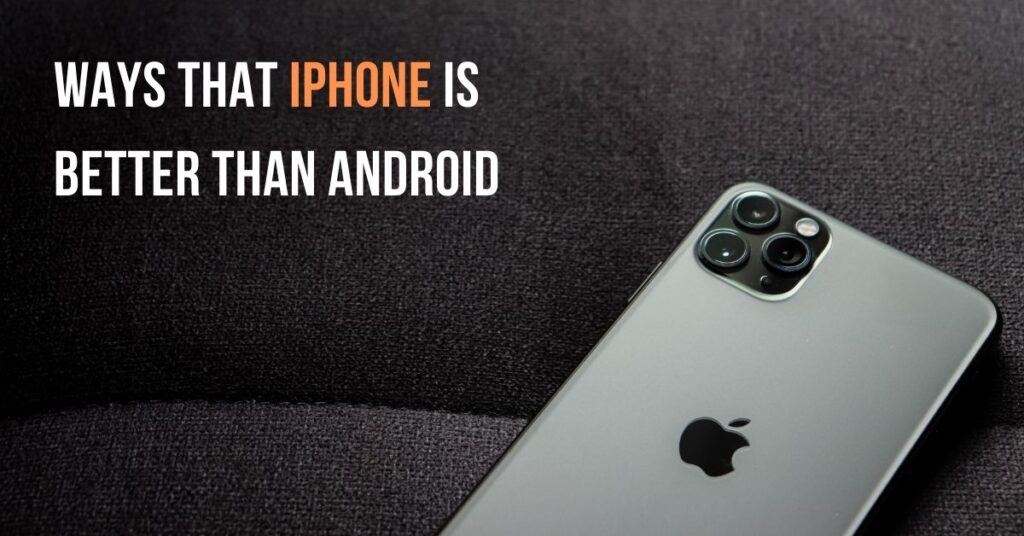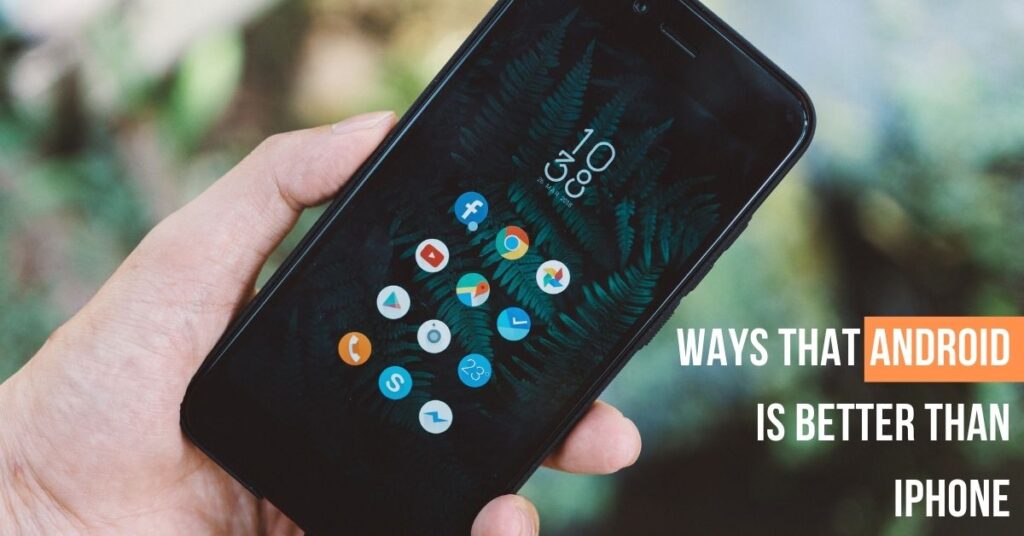
The battle between Android and the iPhone is an endless one. In this article, we compare the advantages of each mobile platform, pitting iPhone vs. Android. Read on to learn more about them—declaring the winner is up to you!
Ways that iPhone is better than Android

Apple has created a wide range of continuity features that let you transfer work and data from one of its devices to another. These capabilities can undoubtedly help you save time.
Few Android phone manufacturers have hardware ecosystems comparable to Apple’s, and even those that do, like Samsung, do not offer the same level of integration that the iPhone and other Apple-built devices can offer. Although the experience is a little clumsy and there is still work to be done, Microsoft is aiding Google in closing the gap with its new Your Phone software for Windows, which allows Android users to respond to SMS and notifications on their PCs.
There are numerous additional excellent examples of continuity between iOS, iPadOS, watchOS, and macOS – and the iPhone is an essential piece of the equation, especially now that iPhone apps can be smoothly moved to macOS. Power users already familiar with Apple’s environment benefit significantly from adding an iPhone to their toolkit. And that’s not even mentioning friends and family who prefer to communicate via FaceTime and iMessage.
It’s more significant than most people realize that more iPhone cases, screen protectors, vehicle mounts, and other accessories are available than any other phone. iPhone owners won’t ever experience the issue of not being able to locate a case they like.
App tracking notifications come with improved privacy controls. With the introduction of app tracking alerts in one of the most significant recent iOS updates, you can choose not to have certain apps monitor you all around your phone. This was an important victory for privacy campaigners and a devastating setback for many third-party businesses, including Facebook.
This capability is just not available on Android and is unlikely ever to be. Don’t hold onto the idea that iOS is more private than Android because Apple still gathers much information about you. Still, iOS does have a little bit more resistance to third parties. Taking away a tracking feature from an app is immensely gratifying.
Quicker software updates are available. Except for Google’s Pixel phones, Android phones receive fewer upgrades than iPhones, and when they do, they are typically delayed and less regular.
The amount of updates an Android phone receives throughout its lifetime primarily relies on how much it costs, the carrier you purchase it from (or whether it was even purchased from a carrier at all), and the software support policies of the phone manufacturer.
Additionally, when a new version of iOS is launched, it is instantly installable on all models that support it and made available to everyone on the same day and simultaneously. In contrast, Android updates are distributed in waves to specific phones rather than just one model at a time.
Better retail support is available. Let’s imagine your iPhone experiences a terrible problem and needs to be repaired. Perhaps you want to install a screen protector on it, but you’d prefer to leave it in the hands of a technician who can apply the film without leaving any bubbles or dust behind. It’s convenient to have a place to go, and where better for iPhone owners to go than the Apple Store, regardless of the situation. Yes, the limitations of Covid can make this challenging, but at least you have the choice.
Android phone owners may not always have that privilege. If the battery or screen has to be replaced and you didn’t buy a protection plan from the merchant where you got it, you’ll probably have to send it back to the maker. Given how much we depend on our phones daily, that is a time-consuming inconvenience. For Pixel phones, there are some trustworthy repair centers like uBreakiFix that assist close the gap a little.
Ways that Android is better than iPhone

Every pricing range is covered by phones. Android is the operating system used by the vast majority of smartphones today, and because so many manufacturers produce Android-based devices, they are affordable for all price points. There are affordable smartphones under $500 like the Pixel 5a, some of the best big and small smartphones, and phablets and foldables that cost significantly more than $1,000. Whatever your budget, there’s probably an Android gadget out there that offers unique features or matches your needs.
The same cannot be said of iPhones, which traditionally have been costly upon release before becoming more affordable with each new generation. The iPhone 13 mini, which costs $699, is one of the most cost-effective new Apple phones, although it only has a 5.4-inch display. The Galaxy S21 FE costs the same but sports a 6.4-inch, 120Hz screen that is bigger and smoother, a telephoto lens, and a significantly bigger battery. The fantastic $599 Pixel 6 is another option if you can locate one.
The iPhone SE (2022), which costs $429 and is a terrific smartphone with incredible performance, is the least priced iPhone Apple produces. However, its look is outdated, and some people may find its screen too small.
It can be customized more. Although iOS and Android have developed over the years, Android has always been the platform for consumers who enjoy customizing and tweaking their devices. That begins with the home screen launcher, which recently caught up to the iPhone with iOS 14. It includes dynamic widgets and the option to put apps wherever on a page or in a drawer, out of sight. You may even download a different launcher from the Google Play store to replace the one that comes with your Android phone.
Suppose you prefer third-party software to one preinstalled on your phone. In that case, Android lets you download third-party replacements for essential services like web browsers, keyboards, and media players and set them as the default versions. Even if iOS’s approach is still a little clumsy, it has evolved in this area over time.
The storage can (sometimes) be increased. Some Android phones still provide expandable storage, even though it is becoming less common nowadays. This enables you to utilize a microSD card to store images, apps, and other media that will not accommodate your device’s internal memory. Given the outrageous fees Apple and other phone manufacturers charge to double or triple storage when you buy your cell phone, it is an excellent perk.
Additionally, some Android devices still include headphone jacks, a feature Apple removed from its phones in 2016 despite becoming less common on high-end phones these days. For those who still adore using their dependable old wired headphones, that is a significant thing.
USB-C is cross-platform. Nowadays, most Android phones use USB-C connections to charge and transfer data, which is very handy if you enjoy traveling light and only take one cable.
Apple’s Lightning cord, on the other hand, is a holdover from the era when every computer company felt forced to create its proprietary connector. In contrast, USB-C is the ultimate single-port solution that the market is striving for. Additionally, it makes way for quicker charging methods.
Android phones are typically the first to get new features. Yes, Apple’s bank account is quite complete. It only has one company and one philosophy, though. Because of this, the iOS community sometimes takes longer than the Android community to adopt new technology.
With so many Android phone manufacturers, it should be no surprise that Android partners frequently launch new mobile technologies before Apple. Before iPhones, Android devices introduced wireless charging, fast charging, NFC, 4G LTE, 5G, OLED displays, in-screen fingerprint sensors, water resistance, and multi-lens cameras. They also introduced software innovations like real multitasking, copy and paste, and multi-window support.
This does not imply that Apple hasn’t made some ground-breaking discoveries. Although the iPhone X was not the first smartphone with face recognition, it was the first with a secure and reliable system. The fact that hardware using Google’s platform is more quickly adaptable is just an issue of scale, given that many more Android phones are introduced from numerous suppliers each year.
So, which one’s the winner in your eyes?
iPhone or Android? Like many purchase decisions, your choice will rely on what you value most. Both systems have advantages and disadvantages.
It’s easier and handier to own an iPhone. There are fewer things to consider, and since Apple’s iPhone is the most widely used smartphone brand, there is a wealth of assistance available everywhere you go, whether you need a new battery or are simply looking to get a new case.
In those ways, owning an Android device is more complicated. However, it also gives you more freedom because more options are available. You can choose how much money you want, what hardware and software feature you want, and how you want to systematize and customize your experience. If you’re incredibly picky about your technology, Android might be more liberating and enjoyable for you. However, you’ll probably also be disappointed by the few high-quality apps (like Twitter) and accessories.
If you’re unsure which smartphone to get, rankings of the greatest iPhones and top Android phones are a great place to start. Whatever you choose, make sure your operating system is compatible with the device.

